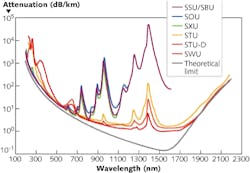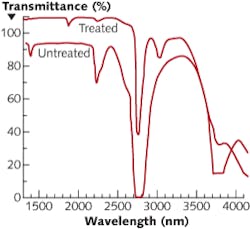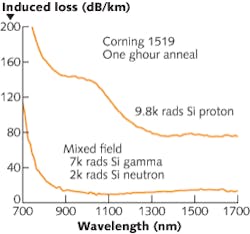JOSEPH S. ACCETTA and JONATHAN D. WEISS
There is substantial concern that nuclear weapons of mass destruction (NWMD) could be smuggled into a US city in the form of nuclear devices, their radioactive components, or materials used in radiological weapons, causing widespread contamination. Because the component materials of these weapons are generally radioactive, detection using conventional radiation detectors has been widely investigated, but certain existing techniques have serious limitations related to issues such as shielding, inherently low levels of radioactivity, and the practicality of "on the fly" border-intensive detection. A new approach to the solid-state detection of neutrons from nuclear devices or materials uses a unique fiber-optic-based detection scheme that has significant potential for use in large, inexpensive, and sensitive NWMD detectors at ports of entry, as well as in small, lightweight clandestine detection devices.
Detection challenges
Nuclear weapons and component materials are difficult to detect by conventional methods at substantial range, especially when shielded. The detection process has to contend with naturally occurring background radiation and be able to discriminate between the two so as not to cause an unacceptable number of false alarms. Neutrons emanating from these types of devices or materials do not interact as charged particles, and as such, most neutron detection techniques rely upon the secondary effects of neutron capture and activation of certain elements whose resulting decay and radiation consist of charged-particle interactions.
The most likely components of NWMD requiring detection are americium 241 (Am241), plutonium 240 (Pu240), Pu238, Pu241, uranium 233 (U233), U235, and highly enriched and low-enriched uranium.1 Some of these elements are either of weapons grade or reactor grade. Associated with all of them is a known or estimated neutron flux having units of neutrons per second-steradian.
The neutron-detection scheme proposed here has its origins in distributed temperature sensing in geothermal (and other energy-producing) wells with optical-fiber sensors. Researchers at Sandia National Laboratories (Albuquerque, NM) and in the geothermal industry reported anomalous readings in certain geothermal wells as part of their evaluation of a downhole fiber-optics-based temperature measurement system.2 A post-mortem spectral analysis of the fibers' transmission indicated that substantial additional optical absorption was caused by the hydroxyl radical (OH) in the glass matrix, which did not exist in the pristine fiber. The researchers concluded that molecular hydrogen originating from within or without the protective stainless-steel sheath diffused into the fiber and reacted with the oxygen of the silica glass matrix at high temperature to form OH. Similar effects were found in undersea fiber-optic cables.3 It might be noted that the OH ions are permanent; unreacted hydrogen will diffuse out of the fiber when the source of hydrogen is removed. One of us (Weiss), while he was still at Sandia National Laboratories, investigated these effects and produced several internal reports, which culminated in the issuance of a patent on a hydrogen-resistant fiber.4 He later submitted an internal proposal on the use of a high-OH fiber as a means of detecting neutrons.
Principle of operation
The proposed detector would use pure-silica-core/fluorinated-silica-clad fibers manufactured, for example, by Heraeus (Hanau, Germany and Buford, GA). A practical advantage of this device is that commercially available fibers can be used without modification. These fibers come in two general categories, high-OH and low-OH. The former contains at most about 1200 parts per million (ppm) of the hydroxyl radical and the latter a few ppm of that same radical. The optical absorption of the preforms from which these fibers are made is specified by the manufacturer (see Fig. 1). The preform with the highest attenuation corresponds to the high-OH fiber and that with the lowest to the low-OH fiber. In the former case, we note the extremely high attenuation at the water peak of 1390 nm and the somewhat lower attenuation at various overtones and combination tones. In addition, we note that at 1850 nm the much lower attenuation does not vary much with OH concentration, probably because it is part of the absorption tail of a pure silica vibration.
The basic detection mechanism of this sensor involves the conversion of OH to deuteroxyl (OD) within the fiber under neutron irradiation. When that happens, the vibrational wavelength shifts from 1390 to 1850 nm because of the increased mass of one neutron. Thus, we expect the optical absorption to diminish at 1390 nm and increase at 1850 nm. Various ways of combining the two signals—positive in one case and negative in the other—will enhance the reliability of the measurement. One would use the fiber with the maximum concentration of OH to maximize the total cross section to neutrons and, if the attenuation at 1390 nm is too high, one would choose a wavelength slightly different from 1390 nm. Doing so would allow for longer fibers, which can be advantageous where distributed sensing is desired.
Transforming OH to OD in optical fibers has been discussed before to shift the OH absorption peak away from the region of the dispersion minimum to 1850 nm. In other words, for high-bandwidth, long-distance fiber-optic communication, it is desirable to have the dispersion and absorption minima at about the same wavelength. In that context, however, it was accomplished through "isotope exchange," not neutron irradiation (deuterium gas diffuses into the fiber and hydrogen gas diffuses out). In this OH to OD isotopic exchange, the 1390 nm transmission minimum disappears and the 1850 nm minimum develops as a result of the treatment (see Fig. 2).5 Thus, we can be confident that the phenomenon exists; it simply has not been realized in the way proposed here.Gamma sensitivity
It is well known that optical fibers darken under the impact of ionizing radiation (including neutrons). This fact would tend to negate the claim made earlier that optical fibers overcome the problem of gamma sensitivity, were the following not also true: Pure-silica-core fibers are generically the least susceptible to such radiation; high-OH, pure-silica-core fibers are even less susceptible than their low-OH counterpart; radiation-induced darkening is both much smaller and much more constant with wavelength in the region of the spectrum under consideration than in the visible and nearer-infrared; and fibers recover from damage caused by gamma and other forms of ionizing radiation, but not from the transformation of a proton to a deuteron.
The smaller and more constant radiation-induced darkening is probably the result of 1390 and 1850 nm lying within the absorption tail of a displacement defect that peaks in the visible or ultraviolet (UV). These facts may allow one to ignore gamma effects completely, use cancellation when comparing the primary neutron effect (OH to OD) at 1390 nm to that at 1850 nm, or wait for recovery in a shielded environment. In addition, any darkening, at say 600 nm, induced by the 2.24 MeV gamma ray emitted internally when hydrogen (H) converts to deuterium (D), could be correlated with the primary neutron effect and produce a more reliable measurement.
An example of the smaller radiation-induced darkening referred to in the previous paragraph can be illustrated graphically (see Fig. 3).6 A particular germanium (Ge)-doped fiber, Corning 1519, was exposed to protons and a mixed gamma-neutron radiation field and was then allowed to recover for an hour. The radiation-induced loss remaining at that time can be shown as a function of wavelength from 700 to 1700 nm. It should be noted that the degree of darkening of an optical fiber typically diminishes with the power density of the light passing through it in addition to the other factors mentioned. This effect, known as photobleaching, occurs because the recovery mechanisms are often optically activated. In fact, workers who have studied fiber darkening have made a point to minimize the power density to avoid complicating the interpretation of their experimental results. However, this can be used to advantage in the current application. High optical power, as can be obtained with a laser source, will reduce the effects of gamma darkening.The fiber-optic advantage
Electromagnetic interference (EMI) immunity and safety are some of the traditional advantages of fiber-optic sensors. Geometric flexibility and low cost are others; the sensor proposed here can assume nearly any shape by winding fibers around variously shaped objects. Multilayer coils can be created of various lengths to capture neutrons emitted over nearly 4 steradians, enabling very large "capture" volumes at very low cost. Alternately some variant of the preform used in the extrusion process could be shaped as required. Due to this flexibility, large-scale detectors could be envisioned that are constructed in highway overpasses and other structures that are large enough and sufficiently sensitive to encompass truck bodies and railroad trains moving at high speed for detection on the move, without attracting significant attention or requiring a slowdown in traffic.
In contrast to neutron activation analysis, which uses a neutron source to bombard the material under inspection, the optical-fiber approach would be totally passive, allaying the fears of nearby personnel being inadvertently irradiated. We note that the fiber-optic neutron-detection mechanism has only been demonstrated in theory; a formal exploratory effort is required for its implementation as an unobtrusive detector for NWMD.
REFERENCES
1. S. Fetter et al., Science and Global Security 1, 225 (1990).
2. C. Smithpeter et al., Proc. 24th Workshop on Geothermal Reservoir Engineering, Stanford University, Stanford, CA (January 1999).
3. J. Stone, J. Lightwave Technology LT-5, 5, 712 (May 1987).
4. "Downhole Geothermal Well Sensors Comprising a Hydrogen-Resistant Optical Fiber," US Patent 6,853,798 B1.
5. B. Kumar, N. Fernelius, and J.A. Detro, Communications of the American Ceramic Society, C-178 to C-180 (December 1981).
6. M.E. Gingerich et al., SPIE Proc. Meeting on Optical Techniques for Sensing and Measurement in Hostile Environments 787, 77 (May 1987).
ACKNOWLEDGMENT
This invention was made with Government support under government contract DE-AC04-94AL85000 awarded by the US Department of Energy to Sandia Corp. The Government has certain rights in the invention, including a paid-up license.
Joseph S. Accetta is a principal scientist at Georgia Tech Research Institute in Atlanta, GA, and CEO of JSA Photonics; and Jonathan D. Weiss is senior scientist at JSA Photonics, 1117 Rio Rancho Blvd. #13, Rio Rancho, NM 87124; e-mail: [email protected]; www.jsaphotonics.com.


